Connected Car Market Size 2025-2029
The connected car market size is valued to increase by USD 138.96 billion, at a CAGR of 17.1% from 2024 to 2029. Increasing internet penetration and its impact on global connected car market will drive the connected car market.
Market Insights
- North America dominated the market and accounted for a 37% growth during the 2025-2029.
- By Connectivity - Embedded solutions segment was valued at USD 36.52 billion in 2023
- By End-user - OEM segment accounted for the largest market revenue share in 2023
Market Size & Forecast
- Market Opportunities: USD 218.99 million
- Market Future Opportunities 2024: USD 138958.30 million
- CAGR from 2024 to 2029 : 17.1%
Market Summary
- The market is experiencing significant growth as the automotive industry embraces digital transformation. With increasing internet penetration worldwide, the demand for connected vehicles is surging. According to the Global System for Mobile Communications Association (GSMA), there were over 100 million connected cars in use in 2020, a figure expected to reach 250 million by 2025. This trend is driven by the launch of numerous vehicles equipped with connected technologies, including real-time traffic information, remote diagnostics, and over-the-air software updates. However, the integration of advanced technologies in connected cars poses design complexity challenges. For instance, ensuring seamless communication between various vehicle systems and external networks requires robust cybersecurity measures.
- Moreover, the need for real-time data processing and low latency adds to the technological intricacy. One real-world business scenario where connected cars can bring substantial benefits is in supply chain optimization. By integrating vehicle telematics data with logistics systems, companies can track their fleet's location and condition in real-time, enabling them to optimize delivery routes and prevent maintenance-related downtime. For example, a leading logistics provider reported a 15% reduction in delivery times and a 20% decrease in maintenance costs after implementing connected vehicle technology in their fleet. Despite these advantages, addressing design complexities and cybersecurity concerns remains crucial for the continued growth and success of the market.
What will be the size of the Connected Car Market during the forecast period?
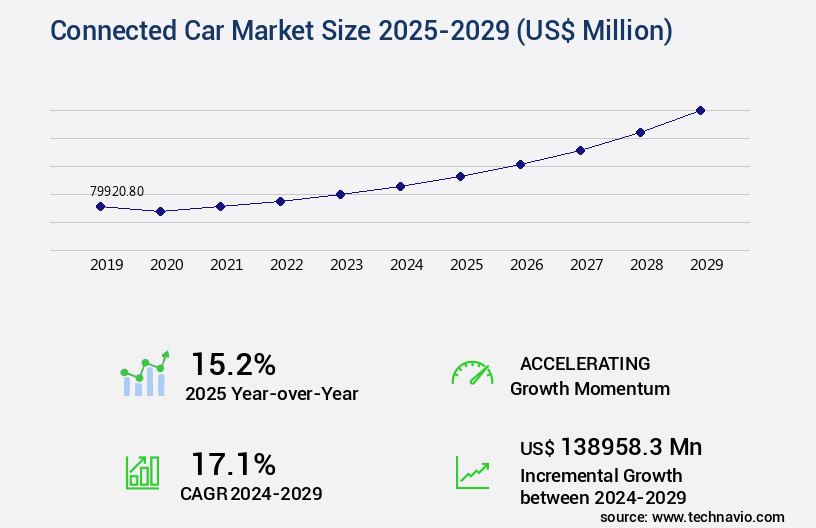
Get Key Insights on Market Forecast (PDF) Request Free Sample
- The market continues to evolve at an unprecedented pace, with innovative technologies such as digital cockpit design, personalized driving experiences, and advanced safety features becoming increasingly standard. According to recent research, the market for connected cars is projected to grow by over 20% in the next year, underscoring the significant business implications for automakers and suppliers. This growth can be attributed to the integration of various technologies, including automatic emergency braking, adaptive cruise control, map data integration, and human-machine interface design. These advancements not only enhance the driving experience but also contribute to improved safety and compliance with regulatory requirements.
- Furthermore, the development of application programming interfaces, firmware updates, and remote vehicle unlocking enables seamless connectivity and convenience for consumers. As businesses navigate this dynamic market, they must consider the implications of these trends on their product strategy, budgeting, and cybersecurity threat detection. With the increasing importance of data analytics and real-time performance metrics, companies must also prioritize network performance monitoring and data encryption methods to protect sensitive information.
Unpacking the Connected Car Market Landscape
In the dynamic realm of connected cars, GPS navigation systems enable real-time route optimization, reducing fuel consumption by up to 15% compared to traditional methods. Location-based services, integrated with infotainment systems, offer personalized recommendations and enhance user experience. Real-time traffic data, sourced via telematics systems, facilitates efficient route planning, saving businesses an average of 30 minutes per day in commuting time. Vehicle data analytics, powered by cloud-based services, provide valuable insights into fleet performance, enabling cost reduction through predictive maintenance and improved ROI. API management ensures seamless integration of connected car features with smartphone applications and IoT platforms. Data security protocols, including vehicle-to-everything communication and driver monitoring systems, safeguard sensitive information and protect against cyber threats. Over-the-air updates and remote diagnostics enable continuous improvement of connected car features, while driver behavior analysis and emergency response systems prioritize safety. Connected cars incorporate advanced driver assistance systems (ADAS) featuring voice recognition technology and ADAS features, enhancing the driving experience and promoting vehicle cybersecurity. CAN bus communication and automotive ethernet facilitate efficient in-vehicle infotainment and network latency reduction. In summary, connected cars offer significant business benefits through improved operational efficiency, enhanced user experience, and increased safety, all underpinned by innovative technologies and robust security protocols.
Key Market Drivers Fueling Growth
The significant expansion of internet penetration serves as the primary catalyst for the growth of the market, as this technological advancement increasingly enables seamless connectivity and advanced features for automobiles.
- The market is experiencing significant evolution, driven by the increasing global Internet penetration and government initiatives to enhance internet infrastructure. As of January 2024, approximately two-thirds of the world's population, or around 66%, utilized the Internet. This trend is expected to continue, providing the foundation for the growing number of applications in connected cars. Governments play a crucial role in this development, with organizations like the European Commission investing in ultra-fast networks to improve Internet infrastructure. By the end of 2025, their goal is to provide internet access at 1 Gbps speed for all schools, transport hubs, and digitally intensive enterprises.
- This robust internet infrastructure is essential for the stable functioning of all connected car features.
Prevailing Industry Trends & Opportunities
The increasing prevalence of connected technologies in vehicle launches represents a significant market trend. This trend reflects the growing demand for advanced technologies in the automotive industry.
- The market is undergoing substantial expansion as automakers integrate advanced technologies into their vehicles to cater to consumers' growing demand for connectivity and safety. This growth is driven by the increasing adoption of features such as Advanced Driver-Assistance Systems (ADAS), real-time navigation, infotainment systems, and remote diagnostics. The proliferation of high-speed networks like 5G is further fueling this trend, enabling vehicle-to-everything (V2X) communication, over-the-air (OTA) updates, and cloud-based services for enhanced user experiences and operational efficiency.
- Regions like North America and Asia-Pacific are leading the way, with high adoption rates due to advanced infrastructure, favorable government policies, and strong consumer demand for tech-rich vehicles.
Significant Market Challenges
The growth of the industry is significantly impacted by the intricate design complexities and formidable technological challenges that must be addressed.
- The market is experiencing a significant evolution, driven by the increasing demand for automotive connectivity solutions. As technological advancements continue to shape the industry, infotainment and telematics systems have become increasingly sophisticated, offering a wide range of features and adverse connectivity options. This complexity, however, poses challenges for automakers. Designing user interfaces that are less distracting, affordable, accessible, and simple is essential to meet consumer expectations. Moreover, the rising number of connected features necessitates a more complex design, with an increasing number of software solutions required for each application.
- To maximize benefits, market players are focusing on efficient handling of these complex solutions. According to recent studies, the number of connected cars is projected to reach 250 million by 2025. This growth underscores the importance of addressing the challenges associated with complex connectivity systems in The market.
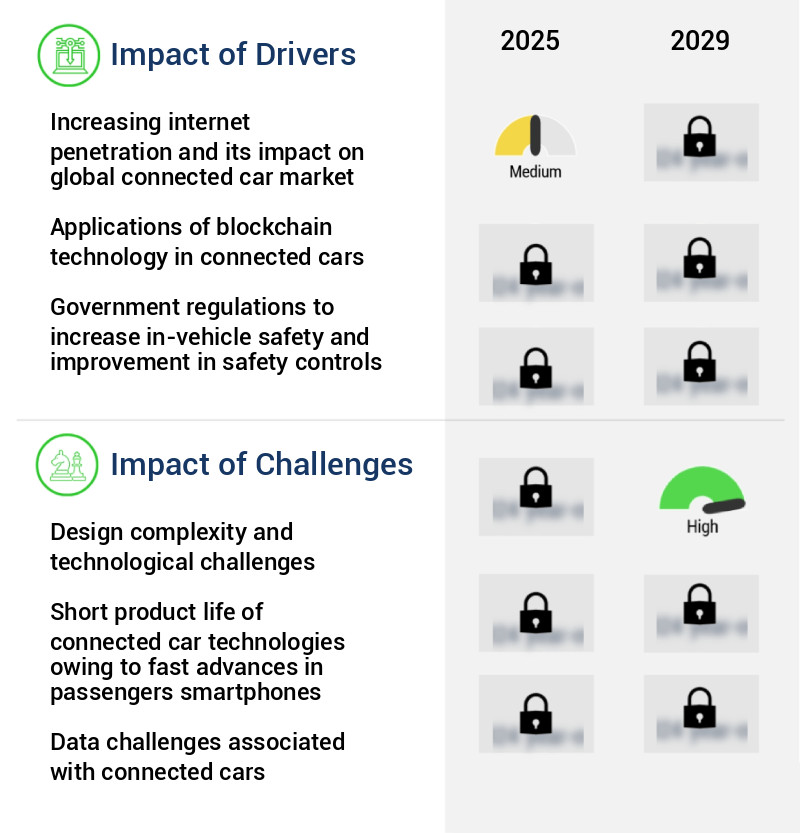
In-Depth Market Segmentation: Connected Car Market
The connected car industry research report provides comprehensive data (region-wise segment analysis), with forecasts and estimates in "USD million" for the period 2025-2029, as well as historical data from 2019-2023 for the following segments.
- Connectivity
- Embedded solutions
- Integrated solutions
- Tethered solutions
- End-user
- Communication Technology
- Geography
- North America
- Europe
- APAC
- China
- India
- Japan
- South Korea
- Rest of World (ROW)
By Connectivity Insights
The embedded solutions segment is estimated to witness significant growth during the forecast period.
In the ever-evolving the market, telematics systems have become an integral part of in-vehicle infotainment, seamlessly integrating GPS navigation, location-based services, real-time traffic data, and vehicle data analytics. Infotainment system design now prioritizes user interface, over-the-air updates, and voice recognition technology, enabling advanced driver assistance systems (ADAS) and driver monitoring. By 2025, 96% of vehicles come equipped with wireless CarPlay and Android Auto, transforming dashboards into smartphone extensions. OEMs collaborate with tech giants like Apple, Google, and Xiaomi to provide cloud-based services, remote diagnostics, and vehicle cybersecurity.
Telematics platforms integrate IoT platforms, cellular connectivity, and CAN bus communication for network latency reduction and embedded sensors. With the rise of software-defined vehicles and automotive ethernet, connected cars are becoming smarter and more secure, offering remote control features, data compression techniques, API management, and emergency response systems.
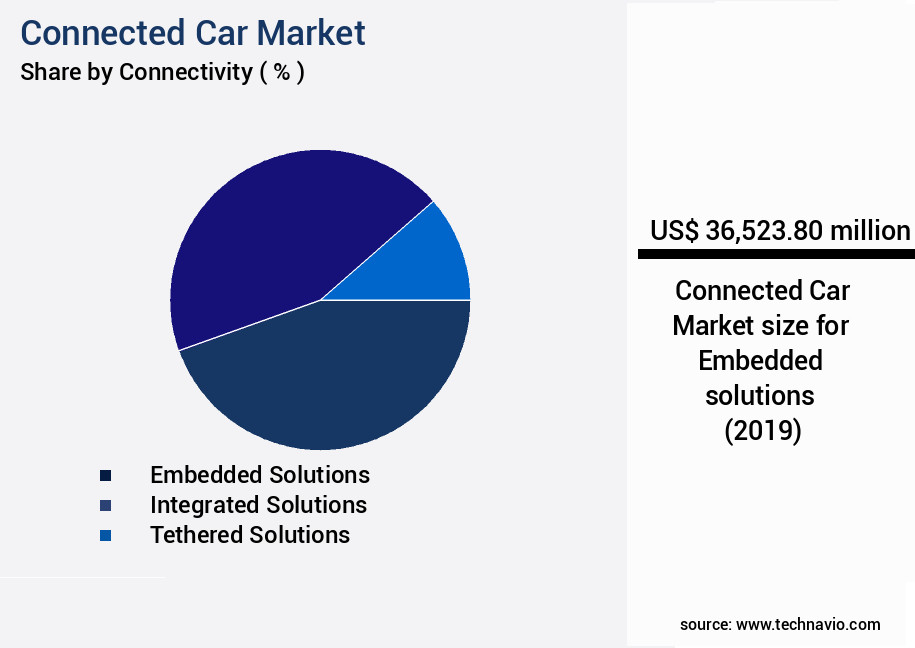
Request Free Sample
The Embedded solutions segment was valued at USD 36.52 billion in 2019 and showed a gradual increase during the forecast period.
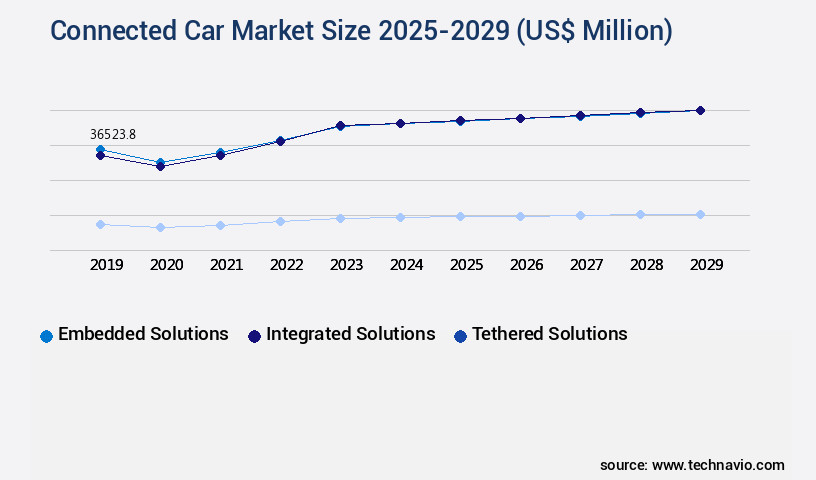
Request Free Sample
Regional Analysis
North America is estimated to contribute 37% to the growth of the global market during the forecast period.Technavio's analysts have elaborately explained the regional trends and drivers that shape the market during the forecast period.
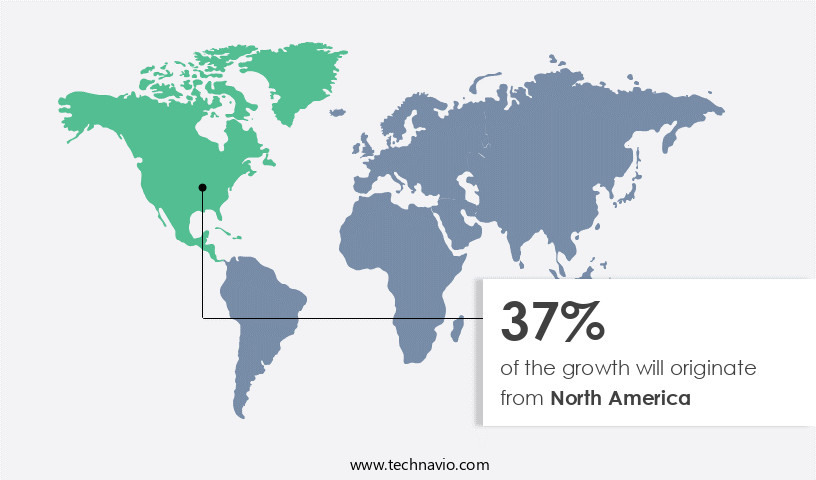
See How Connected Car Market Demand is Rising in North America Request Free Sample
The market in North America is experiencing significant growth, with the US and Canada being major contributors to this expansion. IoT technologies and vehicle-to-vehicle (V2V) connectivity are primary catalysts driving this market's evolution. V2V connectivity is gaining traction, attracting tech companies like Autoliv Inc., Accenture Plc, and Bosch to invest in the US to develop infrastructure with enhanced security support. Stringent regulations from the National Highway Traffic Safety Administration (NHTSA) on road safety improvements have also fueled the adoption of connected features such as crash imminent braking, dynamic brake support, and pedestrian automatic emergency braking in cars.
According to industry reports, the North American the market is projected to reach over USD100 billion by 2025, growing at a robust rate. This growth is attributed to the increasing demand for advanced safety features and the integration of entertainment and infotainment systems in vehicles.
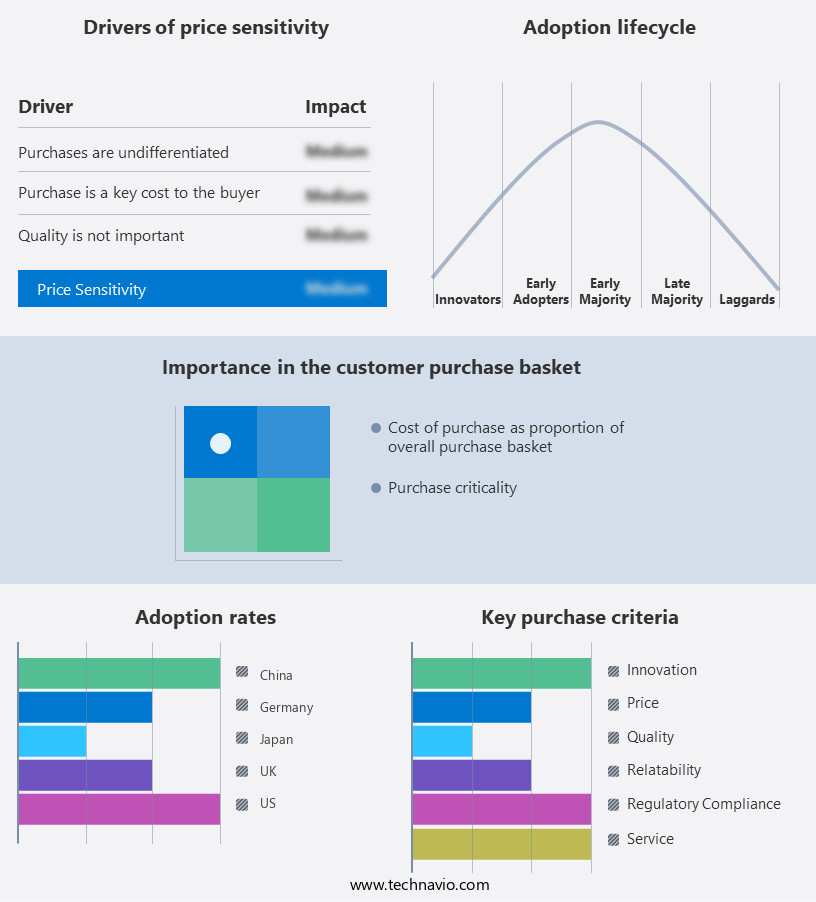
Customer Landscape of Connected Car Industry
Competitive Intelligence by Technavio Analysis: Leading Players in the Connected Car Market
Companies are implementing various strategies, such as strategic alliances, connected car market forecast, partnerships, mergers and acquisitions, geographical expansion, and product/service launches, to enhance their presence in the industry.
Airbiquity Inc. - This tech-savvy firm specializes in connected cars, enabling real-time over-the-air (OTA) software updates and continuous data transmission from onboard systems and components. Their innovative approach enhances vehicle performance and efficiency while ensuring seamless connectivity.
The industry research and growth report includes detailed analyses of the competitive landscape of the market and information about key companies, including:
- Airbiquity Inc.
- Alps Alpine Co. Ltd.
- AT and T Inc.
- Bayerische Motoren Werke AG
- BorgWarner Inc.
- DXC Technology Co.
- Ford Motor Co.
- Information Technologies Institute Intellias LLC
- Mercedes Benz Group AG
- NXP Semiconductors NV
- Qualcomm Inc.
- Robert Bosch GmbH
- Samsung Electronics Co. Ltd.
- Schaeffler AG
- Sierra Wireless Inc.
- Telefonica SA
- Tesla Inc.
- Valeo SA
- Volkswagen AG
- Zubie Inc.
Qualitative and quantitative analysis of companies has been conducted to help clients understand the wider business environment as well as the strengths and weaknesses of key industry players. Data is qualitatively analyzed to categorize companies as pure play, category-focused, industry-focused, and diversified; it is quantitatively analyzed to categorize companies as dominant, leading, strong, tentative, and weak.
Recent Development and News in Connected Car Market
- In August 2024, Tesla, a leading electric vehicle manufacturer, announced the integration of its Autopilot advanced driver-assistance system with Amazon Alexa, enabling in-car voice control for various functions such as navigation, media, and climate control (Tesla Press Release, 2024). This collaboration marked a significant advancement in voice-activated services within connected cars.
- In November 2024, BMW and Intel, in partnership with Mobileye, unveiled the iDrive 7 system, featuring advanced Level 3 autonomous driving capabilities and a new cloud-based platform for over-the-air software updates (BMW Press Release, 2024). This strategic alliance aimed to enhance the driving experience and ensure seamless connectivity for BMW customers.
- In February 2025, Magna International, a global automotive supplier, announced a USD200 million investment in its connected car technology subsidiary, Magna Connected, to expand its offerings and accelerate growth (Magna International Press Release, 2025). This substantial funding round underscored the increasing demand for advanced connectivity solutions in the automotive industry.
- In May 2025, the European Union approved the European Electronic Call System (eCall) regulation, mandating all new passenger cars and light commercial vehicles to be equipped with an eCall system by April 2027 (European Commission Press Release, 2025). This regulatory initiative aimed to improve road safety by ensuring emergency services are notified automatically in case of a serious accident.
Dive into Technavio's robust research methodology, blending expert interviews, extensive data synthesis, and validated models for unparalleled Connected Car Market insights. See full methodology.
|
Market Scope
|
|
Report Coverage
|
Details
|
|
Page number
|
222
|
|
Base year
|
2024
|
|
Historic period
|
2019-2023 |
|
Forecast period
|
2025-2029
|
|
Growth momentum & CAGR
|
Accelerate at a CAGR of 17.1%
|
|
Market growth 2025-2029
|
USD 138958.3 million
|
|
Market structure
|
Fragmented
|
|
YoY growth 2024-2025(%)
|
15.2
|
|
Key countries
|
US, China, UK, Canada, India, Germany, Japan, France, South Korea, and Italy
|
|
Competitive landscape
|
Leading Companies, Market Positioning of Companies, Competitive Strategies, and Industry Risks
|
Request Free Sample
Why Choose Technavio for Connected Car Market Insights?
"Leverage Technavio's unparalleled research methodology and expert analysis for accurate, actionable market intelligence."
The market is experiencing rapid growth, driven by the integration of advanced technologies such as 5G, telematics, and artificial intelligence (AI). The impact of 5G on connected car features is significant, enabling real-time data transfer and faster response times for in-car applications. However, this increased connectivity also brings cybersecurity threats, making it crucial for automakers to prioritize security measures in connected vehicles. The development of in-car user interfaces is another key aspect of the market. These interfaces must be intuitive and user-friendly, integrating advanced driver assistance systems (ADAS) and AI-driven navigation. Cloud computing plays a vital role in connected cars, providing the processing power and storage capacity needed for real-time data analytics and management of over-the-air updates. Telematics and sensor data are essential for predictive maintenance, optimizing connected car network performance, and ensuring driver safety. Real-time data analytics can provide valuable insights into driving patterns and potential safety risks, while voice recognition enhances infotainment systems and improves hands-free operation. The challenges of data security in connected car ecosystems cannot be overlooked.
Effective communication protocols and robust architecture are necessary to protect sensitive information and prevent unauthorized access. The future of connected car technology includes remote diagnostics, advanced safety features, and integration with smart cities, offering significant benefits for both consumers and businesses. Connected car applications are designed and developed with a focus on user experience and functionality. Optimization of connected car network performance is essential for ensuring seamless connectivity and reliable operation. The architecture of connected car platforms must be flexible and scalable, allowing for continuous innovation and improvement. In conclusion, the market is transforming the automotive industry, offering enhanced safety, convenience, and efficiency. The integration of 5G, telematics, AI, and other advanced technologies is driving innovation, but also posing new challenges related to cybersecurity, data privacy, and network performance. Addressing these challenges and continuing to prioritize user experience and safety will be key to the success of connected car technology.
What are the Key Data Covered in this Connected Car Market Research and Growth Report?
-
What is the expected growth of the Connected Car Market between 2025 and 2029?
-
What segmentation does the market report cover?
-
The report is segmented by Connectivity (Embedded solutions, Integrated solutions, and Tethered solutions), End-user (OEM and Aftermarket), Communication Technology (V2I, V2X, and V2V), and Geography (North America, Europe, APAC, South America, and Middle East and Africa)
-
Which regions are analyzed in the report?
-
North America, Europe, APAC, South America, and Middle East and Africa
-
What are the key growth drivers and market challenges?
-
Who are the major players in the Connected Car Market?
-
Airbiquity Inc., Alps Alpine Co. Ltd., AT and T Inc., Bayerische Motoren Werke AG, BorgWarner Inc., DXC Technology Co., Ford Motor Co., Information Technologies Institute Intellias LLC, Mercedes Benz Group AG, NXP Semiconductors NV, Qualcomm Inc., Robert Bosch GmbH, Samsung Electronics Co. Ltd., Schaeffler AG, Sierra Wireless Inc., Telefonica SA, Tesla Inc., Valeo SA, Volkswagen AG, and Zubie Inc.
We can help! Our analysts can customize this connected car market research report to meet your requirements.
Get in touch
1 Executive Summary
- 1.1 Market overview
- Executive Summary - Chart on Market Overview
- Executive Summary - Data Table on Market Overview
- Executive Summary - Chart on Global Market Characteristics
- Executive Summary - Chart on Market by Geography
- Executive Summary - Chart on Market Segmentation by Connectivity
- Executive Summary - Chart on Market Segmentation by End-user
- Executive Summary - Chart on Market Segmentation by Communication Technology
- Executive Summary - Chart on Incremental Growth
- Executive Summary - Data Table on Incremental Growth
- Executive Summary - Chart on Company Market Positioning
2 Technavio Analysis
- 2.1 Analysis of price sensitivity, lifecycle, customer purchase basket, adoption rates, and purchase criteria
- Analysis of price sensitivity, lifecycle, customer purchase basket, adoption rates, and purchase criteria
- 2.2 Criticality of inputs and Factors of differentiation
- Overview on criticality of inputs and factors of differentiation
- 2.3 Factors of disruption
- Overview on factors of disruption
- 2.4 Impact of drivers and challenges
- Impact of drivers and challenges in 2024 and 2029
3 Market Landscape
- 3.1 Market ecosystem
- Parent Market
- Data Table on - Parent Market
- 3.2 Market characteristics
- Market characteristics analysis
4 Market Sizing
- 4.1 Market definition
- Offerings of companies included in the market definition
- 4.2 Market segment analysis
- 4.4 Market outlook: Forecast for 2024-2029
- Chart on Global - Market size and forecast 2024-2029 ($ million)
- Data Table on Global - Market size and forecast 2024-2029 ($ million)
- Chart on Global Market: Year-over-year growth 2024-2029 (%)
- Data Table on Global Market: Year-over-year growth 2024-2029 (%)
5 Historic Market Size
- 5.1 Global Connected Car Market 2019 - 2023
- Historic Market Size - Data Table on Global Connected Car Market 2019 - 2023 ($ million)
- 5.2 Connectivity segment analysis 2019 - 2023
- Historic Market Size - Connectivity Segment 2019 - 2023 ($ million)
- 5.3 End-user segment analysis 2019 - 2023
- Historic Market Size - End-user Segment 2019 - 2023 ($ million)
- 5.4 Communication Technology segment analysis 2019 - 2023
- Historic Market Size - Communication Technology Segment 2019 - 2023 ($ million)
- 5.5 Geography segment analysis 2019 - 2023
- Historic Market Size - Geography Segment 2019 - 2023 ($ million)
- 5.6 Country segment analysis 2019 - 2023
- Historic Market Size - Country Segment 2019 - 2023 ($ million)
6 Qualitative Analysis
- 6.1 The AI impact on Global Connected Car Market
7 Five Forces Analysis
- 7.1 Five forces summary
- Five forces analysis - Comparison between 2024 and 2029
- 7.2 Bargaining power of buyers
- Bargaining power of buyers - Impact of key factors 2024 and 2029
- 7.3 Bargaining power of suppliers
- Bargaining power of suppliers - Impact of key factors in 2024 and 2029
- 7.4 Threat of new entrants
- Threat of new entrants - Impact of key factors in 2024 and 2029
- 7.5 Threat of substitutes
- Threat of substitutes - Impact of key factors in 2024 and 2029
- 7.6 Threat of rivalry
- Threat of rivalry - Impact of key factors in 2024 and 2029
- 7.7 Market condition
- Chart on Market condition - Five forces 2024 and 2029
8 Market Segmentation by Connectivity
- 8.1 Market segments
- Chart on Connectivity - Market share 2024-2029 (%)
- Data Table on Connectivity - Market share 2024-2029 (%)
- 8.2 Comparison by Connectivity
- Chart on Comparison by Connectivity
- Data Table on Comparison by Connectivity
- 8.3 Embedded solutions - Market size and forecast 2024-2029
- Chart on Embedded solutions - Market size and forecast 2024-2029 ($ million)
- Data Table on Embedded solutions - Market size and forecast 2024-2029 ($ million)
- Chart on Embedded solutions - Year-over-year growth 2024-2029 (%)
- Data Table on Embedded solutions - Year-over-year growth 2024-2029 (%)
- 8.4 Integrated solutions - Market size and forecast 2024-2029
- Chart on Integrated solutions - Market size and forecast 2024-2029 ($ million)
- Data Table on Integrated solutions - Market size and forecast 2024-2029 ($ million)
- Chart on Integrated solutions - Year-over-year growth 2024-2029 (%)
- Data Table on Integrated solutions - Year-over-year growth 2024-2029 (%)
- 8.5 Tethered solutions - Market size and forecast 2024-2029
- Chart on Tethered solutions - Market size and forecast 2024-2029 ($ million)
- Data Table on Tethered solutions - Market size and forecast 2024-2029 ($ million)
- Chart on Tethered solutions - Year-over-year growth 2024-2029 (%)
- Data Table on Tethered solutions - Year-over-year growth 2024-2029 (%)
- 8.6 Market opportunity by Connectivity
- Market opportunity by Connectivity ($ million)
- Data Table on Market opportunity by Connectivity ($ million)
9 Market Segmentation by End-user
- 9.1 Market segments
- Chart on End-user - Market share 2024-2029 (%)
- Data Table on End-user - Market share 2024-2029 (%)
- 9.2 Comparison by End-user
- Chart on Comparison by End-user
- Data Table on Comparison by End-user
- 9.3 OEM - Market size and forecast 2024-2029
- Chart on OEM - Market size and forecast 2024-2029 ($ million)
- Data Table on OEM - Market size and forecast 2024-2029 ($ million)
- Chart on OEM - Year-over-year growth 2024-2029 (%)
- Data Table on OEM - Year-over-year growth 2024-2029 (%)
- 9.4 Aftermarket - Market size and forecast 2024-2029
- Chart on Aftermarket - Market size and forecast 2024-2029 ($ million)
- Data Table on Aftermarket - Market size and forecast 2024-2029 ($ million)
- Chart on Aftermarket - Year-over-year growth 2024-2029 (%)
- Data Table on Aftermarket - Year-over-year growth 2024-2029 (%)
- 9.5 Market opportunity by End-user
- Market opportunity by End-user ($ million)
- Data Table on Market opportunity by End-user ($ million)
10 Market Segmentation by Communication Technology
- 10.1 Market segments
- Chart on Communication Technology - Market share 2024-2029 (%)
- Data Table on Communication Technology - Market share 2024-2029 (%)
- 10.2 Comparison by Communication Technology
- Chart on Comparison by Communication Technology
- Data Table on Comparison by Communication Technology
- 10.3 V2I - Market size and forecast 2024-2029
- Chart on V2I - Market size and forecast 2024-2029 ($ million)
- Data Table on V2I - Market size and forecast 2024-2029 ($ million)
- Chart on V2I - Year-over-year growth 2024-2029 (%)
- Data Table on V2I - Year-over-year growth 2024-2029 (%)
- 10.4 V2X - Market size and forecast 2024-2029
- Chart on V2X - Market size and forecast 2024-2029 ($ million)
- Data Table on V2X - Market size and forecast 2024-2029 ($ million)
- Chart on V2X - Year-over-year growth 2024-2029 (%)
- Data Table on V2X - Year-over-year growth 2024-2029 (%)
- 10.5 V2V - Market size and forecast 2024-2029
- Chart on V2V - Market size and forecast 2024-2029 ($ million)
- Data Table on V2V - Market size and forecast 2024-2029 ($ million)
- Chart on V2V - Year-over-year growth 2024-2029 (%)
- Data Table on V2V - Year-over-year growth 2024-2029 (%)
- 10.6 Market opportunity by Communication Technology
- Market opportunity by Communication Technology ($ million)
- Data Table on Market opportunity by Communication Technology ($ million)
11 Customer Landscape
- 11.1 Customer landscape overview
- Analysis of price sensitivity, lifecycle, customer purchase basket, adoption rates, and purchase criteria
12 Geographic Landscape
- 12.1 Geographic segmentation
- Chart on Market share by geography 2024-2029 (%)
- Data Table on Market share by geography 2024-2029 (%)
- 12.2 Geographic comparison
- Chart on Geographic comparison
- Data Table on Geographic comparison
- 12.3 North America - Market size and forecast 2024-2029
- Chart on North America - Market size and forecast 2024-2029 ($ million)
- Data Table on North America - Market size and forecast 2024-2029 ($ million)
- Chart on North America - Year-over-year growth 2024-2029 (%)
- Data Table on North America - Year-over-year growth 2024-2029 (%)
- 12.4 Europe - Market size and forecast 2024-2029
- Chart on Europe - Market size and forecast 2024-2029 ($ million)
- Data Table on Europe - Market size and forecast 2024-2029 ($ million)
- Chart on Europe - Year-over-year growth 2024-2029 (%)
- Data Table on Europe - Year-over-year growth 2024-2029 (%)
- 12.5 APAC - Market size and forecast 2024-2029
- Chart on APAC - Market size and forecast 2024-2029 ($ million)
- Data Table on APAC - Market size and forecast 2024-2029 ($ million)
- Chart on APAC - Year-over-year growth 2024-2029 (%)
- Data Table on APAC - Year-over-year growth 2024-2029 (%)
- 12.6 South America - Market size and forecast 2024-2029
- Chart on South America - Market size and forecast 2024-2029 ($ million)
- Data Table on South America - Market size and forecast 2024-2029 ($ million)
- Chart on South America - Year-over-year growth 2024-2029 (%)
- Data Table on South America - Year-over-year growth 2024-2029 (%)
- 12.7 Middle East and Africa - Market size and forecast 2024-2029
- Chart on Middle East and Africa - Market size and forecast 2024-2029 ($ million)
- Data Table on Middle East and Africa - Market size and forecast 2024-2029 ($ million)
- Chart on Middle East and Africa - Year-over-year growth 2024-2029 (%)
- Data Table on Middle East and Africa - Year-over-year growth 2024-2029 (%)
- 12.8 US - Market size and forecast 2024-2029
- Chart on US - Market size and forecast 2024-2029 ($ million)
- Data Table on US - Market size and forecast 2024-2029 ($ million)
- Chart on US - Year-over-year growth 2024-2029 (%)
- Data Table on US - Year-over-year growth 2024-2029 (%)
- 12.9 China - Market size and forecast 2024-2029
- Chart on China - Market size and forecast 2024-2029 ($ million)
- Data Table on China - Market size and forecast 2024-2029 ($ million)
- Chart on China - Year-over-year growth 2024-2029 (%)
- Data Table on China - Year-over-year growth 2024-2029 (%)
- 12.10 UK - Market size and forecast 2024-2029
- Chart on UK - Market size and forecast 2024-2029 ($ million)
- Data Table on UK - Market size and forecast 2024-2029 ($ million)
- Chart on UK - Year-over-year growth 2024-2029 (%)
- Data Table on UK - Year-over-year growth 2024-2029 (%)
- 12.11 Canada - Market size and forecast 2024-2029
- Chart on Canada - Market size and forecast 2024-2029 ($ million)
- Data Table on Canada - Market size and forecast 2024-2029 ($ million)
- Chart on Canada - Year-over-year growth 2024-2029 (%)
- Data Table on Canada - Year-over-year growth 2024-2029 (%)
- 12.12 Germany - Market size and forecast 2024-2029
- Chart on Germany - Market size and forecast 2024-2029 ($ million)
- Data Table on Germany - Market size and forecast 2024-2029 ($ million)
- Chart on Germany - Year-over-year growth 2024-2029 (%)
- Data Table on Germany - Year-over-year growth 2024-2029 (%)
- 12.13 India - Market size and forecast 2024-2029
- Chart on India - Market size and forecast 2024-2029 ($ million)
- Data Table on India - Market size and forecast 2024-2029 ($ million)
- Chart on India - Year-over-year growth 2024-2029 (%)
- Data Table on India - Year-over-year growth 2024-2029 (%)
- 12.14 France - Market size and forecast 2024-2029
- Chart on France - Market size and forecast 2024-2029 ($ million)
- Data Table on France - Market size and forecast 2024-2029 ($ million)
- Chart on France - Year-over-year growth 2024-2029 (%)
- Data Table on France - Year-over-year growth 2024-2029 (%)
- 12.15 Japan - Market size and forecast 2024-2029
- Chart on Japan - Market size and forecast 2024-2029 ($ million)
- Data Table on Japan - Market size and forecast 2024-2029 ($ million)
- Chart on Japan - Year-over-year growth 2024-2029 (%)
- Data Table on Japan - Year-over-year growth 2024-2029 (%)
- 12.16 South Korea - Market size and forecast 2024-2029
- Chart on South Korea - Market size and forecast 2024-2029 ($ million)
- Data Table on South Korea - Market size and forecast 2024-2029 ($ million)
- Chart on South Korea - Year-over-year growth 2024-2029 (%)
- Data Table on South Korea - Year-over-year growth 2024-2029 (%)
- 12.17 Italy - Market size and forecast 2024-2029
- Chart on Italy - Market size and forecast 2024-2029 ($ million)
- Data Table on Italy - Market size and forecast 2024-2029 ($ million)
- Chart on Italy - Year-over-year growth 2024-2029 (%)
- Data Table on Italy - Year-over-year growth 2024-2029 (%)
- 12.18 Market opportunity by geography
- Market opportunity by geography ($ million)
- Data Tables on Market opportunity by geography ($ million)
13 Drivers, Challenges, and Opportunity/Restraints
- 13.3 Impact of drivers and challenges
- Impact of drivers and challenges in 2024 and 2029
- 13.4 Market opportunities/restraints
14 Competitive Landscape
- 14.2 Competitive Landscape
- Overview on criticality of inputs and factors of differentiation
- 14.3 Landscape disruption
- Overview on factors of disruption
- 14.4 Industry risks
- Impact of key risks on business
15 Competitive Analysis
- 15.2 Company ranking index
- 15.3 Market positioning of companies
- Matrix on companies position and classification
- 15.4 Airbiquity Inc.
- Airbiquity Inc. - Overview
- Airbiquity Inc. - Product / Service
- Airbiquity Inc. - Key offerings
- SWOT
- 15.5 Alps Alpine Co. Ltd.
- Alps Alpine Co. Ltd. - Overview
- Alps Alpine Co. Ltd. - Business segments
- Alps Alpine Co. Ltd. - Key news
- Alps Alpine Co. Ltd. - Key offerings
- Alps Alpine Co. Ltd. - Segment focus
- SWOT
- 15.6 AT and T Inc.
- AT and T Inc. - Overview
- AT and T Inc. - Business segments
- AT and T Inc. - Key news
- AT and T Inc. - Key offerings
- AT and T Inc. - Segment focus
- SWOT
- 15.7 Bayerische Motoren Werke AG
- Bayerische Motoren Werke AG - Overview
- Bayerische Motoren Werke AG - Business segments
- Bayerische Motoren Werke AG - Key offerings
- Bayerische Motoren Werke AG - Segment focus
- SWOT
- 15.8 BorgWarner Inc.
- BorgWarner Inc. - Overview
- BorgWarner Inc. - Business segments
- BorgWarner Inc. - Key news
- BorgWarner Inc. - Key offerings
- BorgWarner Inc. - Segment focus
- SWOT
- 15.9 DXC Technology Co.
- DXC Technology Co. - Overview
- DXC Technology Co. - Business segments
- DXC Technology Co. - Key news
- DXC Technology Co. - Key offerings
- DXC Technology Co. - Segment focus
- SWOT
- 15.10 Ford Motor Co.
- Ford Motor Co. - Overview
- Ford Motor Co. - Business segments
- Ford Motor Co. - Key offerings
- Ford Motor Co. - Segment focus
- SWOT
- 15.11 Information Technologies Institute Intellias LLC
- Information Technologies Institute Intellias LLC - Overview
- Information Technologies Institute Intellias LLC - Product / Service
- Information Technologies Institute Intellias LLC - Key offerings
- SWOT
- 15.12 Mercedes Benz Group AG
- Mercedes Benz Group AG - Overview
- Mercedes Benz Group AG - Product / Service
- Mercedes Benz Group AG - Key offerings
- SWOT
- 15.13 NXP Semiconductors NV
- NXP Semiconductors NV - Overview
- NXP Semiconductors NV - Product / Service
- NXP Semiconductors NV - Key offerings
- SWOT
- 15.14 Schaeffler AG
- Schaeffler AG - Overview
- Schaeffler AG - Business segments
- Schaeffler AG - Key news
- Schaeffler AG - Key offerings
- Schaeffler AG - Segment focus
- SWOT
- 15.15 Tesla Inc.
- Tesla Inc. - Overview
- Tesla Inc. - Business segments
- Tesla Inc. - Key news
- Tesla Inc. - Key offerings
- Tesla Inc. - Segment focus
- SWOT
- 15.16 Valeo SA
- Valeo SA - Overview
- Valeo SA - Business segments
- Valeo SA - Key news
- Valeo SA - Key offerings
- Valeo SA - Segment focus
- SWOT
- 15.17 Volkswagen AG
- Volkswagen AG - Overview
- Volkswagen AG - Business segments
- Volkswagen AG - Key news
- Volkswagen AG - Key offerings
- Volkswagen AG - Segment focus
- SWOT
- 15.18 Zubie Inc.
- Zubie Inc. - Overview
- Zubie Inc. - Product / Service
- Zubie Inc. - Key offerings
- SWOT
16 Appendix
- 16.2 Inclusions and exclusions checklist
- Inclusions checklist
- Exclusions checklist
- 16.3 Currency conversion rates for US$
- Currency conversion rates for US$
- 16.4 Research methodology
- 16.7 Validation techniques employed for market sizing
- Validation techniques employed for market sizing
- 16.9 360 degree market analysis
- 360 degree market analysis
- 16.10 List of abbreviations







![]() Get the report (PDF) sent to your email within minutes.
Get the report (PDF) sent to your email within minutes.
Complimentary full Excel data with your report purchase.